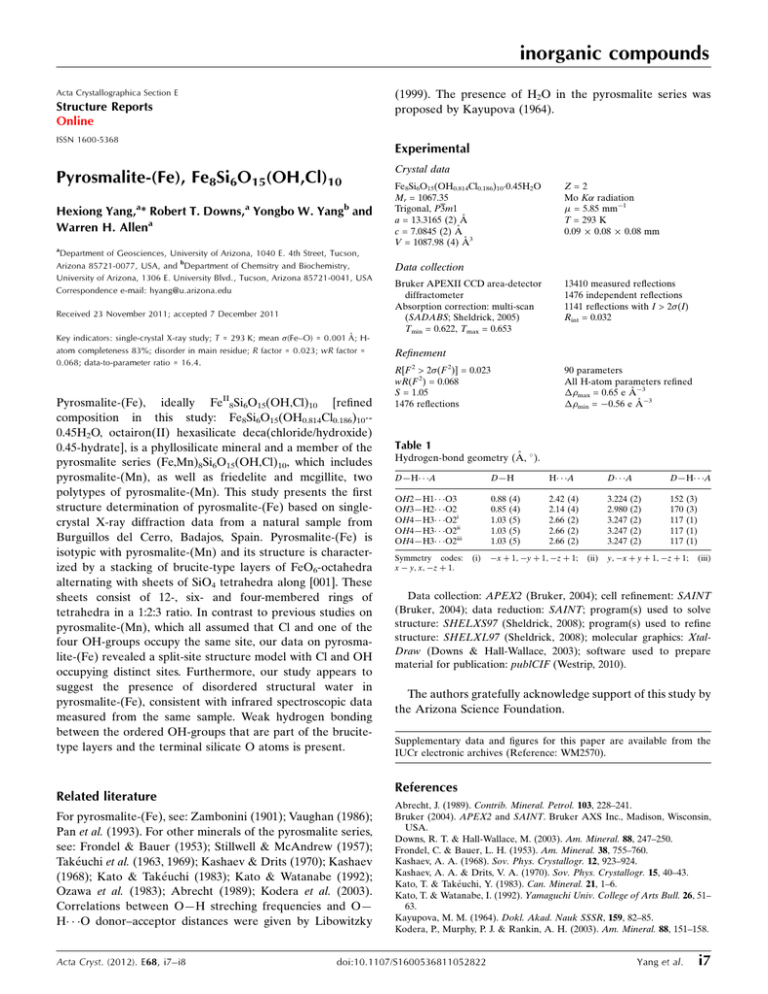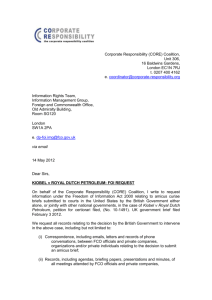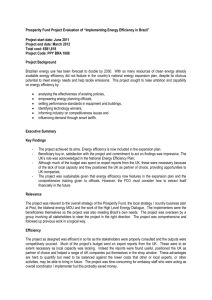Pyrosmalite-(Fe), Fe Si O (OH,Cl)
advertisement

inorganic compounds Acta Crystallographica Section E (1999). The presence of H2O in the pyrosmalite series was proposed by Kayupova (1964). Structure Reports Online ISSN 1600-5368 Experimental Pyrosmalite-(Fe), Fe8Si6O15(OH,Cl)10 Hexiong Yang,a* Robert T. Downs,a Yongbo W. Yangb and Warren H. Allena a Department of Geosciences, University of Arizona, 1040 E. 4th Street, Tucson, Arizona 85721-0077, USA, and bDepartment of Chemsitry and Biochemistry, University of Arizona, 1306 E. University Blvd., Tucson, Arizona 85721-0041, USA Correspondence e-mail: hyang@u.arizona.edu Received 23 November 2011; accepted 7 December 2011 Key indicators: single-crystal X-ray study; T = 293 K; mean (Fe–O) = 0.001 Å; Hatom completeness 83%; disorder in main residue; R factor = 0.023; wR factor = 0.068; data-to-parameter ratio = 16.4. Pyrosmalite-(Fe), ideally FeII8Si6O15(OH,Cl)10 [refined composition in this study: Fe8Si6O15(OH0.814Cl0.186)100.45H2O, octairon(II) hexasilicate deca(chloride/hydroxide) 0.45-hydrate], is a phyllosilicate mineral and a member of the pyrosmalite series (Fe,Mn)8Si6O15(OH,Cl)10, which includes pyrosmalite-(Mn), as well as friedelite and mcgillite, two polytypes of pyrosmalite-(Mn). This study presents the first structure determination of pyrosmalite-(Fe) based on singlecrystal X-ray diffraction data from a natural sample from Burguillos del Cerro, Badajos, Spain. Pyrosmalite-(Fe) is isotypic with pyrosmalite-(Mn) and its structure is characterized by a stacking of brucite-type layers of FeO6-octahedra alternating with sheets of SiO4 tetrahedra along [001]. These sheets consist of 12-, six- and four-membered rings of tetrahedra in a 1:2:3 ratio. In contrast to previous studies on pyrosmalite-(Mn), which all assumed that Cl and one of the four OH-groups occupy the same site, our data on pyrosmalite-(Fe) revealed a split-site structure model with Cl and OH occupying distinct sites. Furthermore, our study appears to suggest the presence of disordered structural water in pyrosmalite-(Fe), consistent with infrared spectroscopic data measured from the same sample. Weak hydrogen bonding between the ordered OH-groups that are part of the brucitetype layers and the terminal silicate O atoms is present. Fe8Si6O15(OH0.814Cl0.186)100.45H2O Mr = 1067.35 Trigonal, P3m1 a = 13.3165 (2) Å c = 7.0845 (2) Å V = 1087.98 (4) Å3 Z=2 Mo K radiation = 5.85 mm1 T = 293 K 0.09 0.08 0.08 mm Data collection Bruker APEXII CCD area-detector diffractometer Absorption correction: multi-scan (SADABS; Sheldrick, 2005) Tmin = 0.622, Tmax = 0.653 13410 measured reflections 1476 independent reflections 1141 reflections with I > 2(I) Rint = 0.032 Refinement R[F 2 > 2(F 2)] = 0.023 wR(F 2) = 0.068 S = 1.05 1476 reflections 90 parameters All H-atom parameters refined max = 0.65 e Å3 min = 0.56 e Å3 Table 1 Hydrogen-bond geometry (Å, ). D—H A D—H H A D A D—H A OH2—H1 O3 OH3—H2 O2 OH4—H3 O2i OH4—H3 O2ii OH4—H3 O2iii 0.88 (4) 0.85 (4) 1.03 (5) 1.03 (5) 1.03 (5) 2.42 2.14 2.66 2.66 2.66 3.224 2.980 3.247 3.247 3.247 152 170 117 117 117 Symmetry codes: x y; x; z þ 1. (i) (4) (4) (2) (2) (2) x þ 1; y þ 1; z þ 1; (ii) (2) (2) (2) (2) (2) (3) (3) (1) (1) (1) y; x þ y þ 1; z þ 1; (iii) Data collection: APEX2 (Bruker, 2004); cell refinement: SAINT (Bruker, 2004); data reduction: SAINT; program(s) used to solve structure: SHELXS97 (Sheldrick, 2008); program(s) used to refine structure: SHELXL97 (Sheldrick, 2008); molecular graphics: XtalDraw (Downs & Hall-Wallace, 2003); software used to prepare material for publication: publCIF (Westrip, 2010). The authors gratefully acknowledge support of this study by the Arizona Science Foundation. Supplementary data and figures for this paper are available from the IUCr electronic archives (Reference: WM2570). References Related literature For pyrosmalite-(Fe), see: Zambonini (1901); Vaughan (1986); Pan et al. (1993). For other minerals of the pyrosmalite series, see: Frondel & Bauer (1953); Stillwell & McAndrew (1957); Takéuchi et al. (1963, 1969); Kashaev & Drits (1970); Kashaev (1968); Kato & Takéuchi (1983); Kato & Watanabe (1992); Ozawa et al. (1983); Abrecht (1989); Kodera et al. (2003). Correlations between O—H streching frequencies and O— H O donor–acceptor distances were given by Libowitzky Acta Cryst. (2012). E68, i7–i8 Crystal data Abrecht, J. (1989). Contrib. Mineral. Petrol. 103, 228–241. Bruker (2004). APEX2 and SAINT. Bruker AXS Inc., Madison, Wisconsin, USA. Downs, R. T. & Hall-Wallace, M. (2003). Am. Mineral. 88, 247–250. Frondel, C. & Bauer, L. H. (1953). Am. Mineral. 38, 755–760. Kashaev, A. A. (1968). Sov. Phys. Crystallogr. 12, 923–924. Kashaev, A. A. & Drits, V. A. (1970). Sov. Phys. Crystallogr. 15, 40–43. Kato, T. & Takéuchi, Y. (1983). Can. Mineral. 21, 1–6. Kato, T. & Watanabe, I. (1992). Yamaguchi Univ. College of Arts Bull. 26, 51– 63. Kayupova, M. M. (1964). Dokl. Akad. Nauk SSSR, 159, 82–85. Kodera, P., Murphy, P. J. & Rankin, A. H. (2003). Am. Mineral. 88, 151–158. doi:10.1107/S1600536811052822 Yang et al. i7 inorganic compounds Libowitzky, E. (1999). Monatsh. Chem. 130, 1047–1059. Ozawa, T., Takéuchi, Y., Takahata, T., Donnay, G. & Donnay, J. D. H. (1983). Can. Mineral. 21, 7–17. Pan, Y., Fleet, M. E., Barnett, R. L. & Chen, Y. (1993). Can. Mineral. 31, 695– 710. Sheldrick, G. M. (2005). SADABS. University of Göttingen, Germany. Sheldrick, G. M. (2008). Acta Cryst. A64, 112–122. i8 Yang et al. Fe8Si6O15(OH0.814Cl0.186)100.45H2O Stillwell, F. & McAndrew, J. (1957). Mineral. Mag. 31, 371–380. Takéuchi, Y., Kawada, I., Irimaziri, S. & Sandanga, R. (1969). Miner. J. 5, 450– 467. Takéuchi, Y., Kawada, I. & Sandanga, R. (1963). Acta Cryst. 16, A16. Vaughan, J. P. (1986). Mineral. Mag. 50, 527–531. Westrip, S. P. (2010). J. Appl. Cryst. 43, 920–925. Zambonini, F. (1901). Z. Kristallogr. 34, 554–561. Acta Cryst. (2012). E68, i7–i8 supplementary materials supplementary materials Acta Cryst. (2012). E68, i7-i8 [ doi:10.1107/S1600536811052822 ] Pyrosmalite-(Fe), Fe8Si6O15(OH,Cl)10 H. Yang, R. T. Downs, Y. W. Yang and W. H. Allen Comment Pyrosmalite is the name given to the phyllosilicate series with the general chemical formula (Fe,Mn)8Si6O15(OH,Cl)10. Minerals of the pyrosmalite series are generally related to metamorphism in close association with Fe- and Mn-rich silicates and oxides (e.g., Frondel & Bauer, 1953; Stillwell & McAndrew, 1957; Vaughan, 1986; Abrecht, 1989; Pan et al., 1993; Kodera et al., 2003). The Fe-rich members of the series are called pyrosmalite-(Fe) (previously ferropyrosmalite), whereas the Mn-rich members include pyrosmalite-(Mn) (previously manganpyrosmalite), and friedelite, a polytype of the series with the c-axis three times that of pyrosmalite-(Mn), as well as mcgillite, Mn8Si6O15(OH)8Cl2, an ordered form of friedelite with the c-axis twelve times that of pyrosmalite-(Mn) (Ozawa et al., 1983). The polytypism in the pyrosmalite group of minerals has been regarded to be similar to that of the micas (Frondel & Bauer, 1953; Takéuchi et al., 1969; Kashaev & Drits, 1970; Kato & Takéuchi, 1983; Ozawa et al., 1983). The crystal structure of pyrosmalite-(Mn) was first investigated by Takéuchi et al. (1963) without giving any detailed structure information. Kashaev (1968) reported a partial structure model for pyrosmalite-(Mn) based on photographic X-ray intensity data of 35 reflections collected from a crystal with XFe = Fe / (Fe + Mn) = 0.39. By means of Weissenberg and precession methods, Takéuchi et al. (1969) determined the structure of pyrosmalite-(Mn) from a crystal with XFe = 0.18 (R = 19.8%). Using a four-circle X-ray diffractometer, Kato & Takéuchi (1983) examined two pyrosmalite-(Mn) crystals, one having XFe = 0.46 and the other XFe = 0.18. Their structure refinements on atomic coordinates and isotropic displacement parameters resulted in R = 6.0% and 10.5% for the former and latter crystals, respectively. The structure of friedelite was solved by Kato & Watanabe (1992) in space group C2/m (R = 20.3%). However, despite its first description in the early twentieth century (Zambonini, 1901), the structure of pyrosmalite-(Fe) has remained undetermined hitherto. This study presents the first structure refinement of pyrosmalite-(Fe) on the basis of single-crystal X-ray diffraction data. Pyrosmalite-(Fe) is isotypic with pyrosmalite-(Mn) (Kashaev, 1968; Takéuchi et al., 1969; Kato & Takéuchi, 1983). Its structure is characterized by brucite-type layers of FeO6-octahedra alternating with sheets of SiO4 tetrahedra along [001]. The tetrahedral sheets consist of 12-, 6-, and 4-membered rings of SiO4 tetrahedra with a ratio of 1:2:3 (Figs. 1 and 2). Kato & Takéuchi (1983) noted that the SiO4 tetrahedra in pyrosmalite-(Mn) are elongated towards their apical oxygen atoms (O4). Similar results have also been found in pyrosmalite-(Fe). The average length (2.678 Å) of the pyramidal edges is 4.3% longer than that (2.568 Å) of the basal edges. It is intriguing to note that all previous structure refinements on pyrosmalite-(Mn) assumed a disordered model with Cl and OH1 occupying the same site, which resulted in a markedly large isotropic displacement parameter for the site that is more than twice as large as that of other anion sites, and R > 6% (Takéuchi et al., 1969; Kato & Takéuchi, 1983). Using the same disorder model for Cl and OH1, we arrived at similar results [R1 = 6.1%, GOF = 1.621, and an unreasonably large Uiso value for the (OH1,Cl) site]. Examination of difference Fourier maps from our structure refinements, nonetheless, uncovered an outstanding residual peak that is 0.74 Å away from OH1. By introducing a split-site model, in which Cl and OH1 occupy symmetrically distinct sites, we obtained R1 = 2.89% and sup-1 supplementary materials GOF = 1.076. The refined Cl content from the split-site model is 1.86 atoms per formula unit (apfu), in excellent agreement with the value of 1.7 apfu from the electron microprobe analysis. Another interesting feature from our structure refinement on pyrosmalite-(Fe) is a small, but noticeable residual peak in the difference Fourier synthesis, which is located within the 12-membered tetrahedral rings (Fig. 1). Because the determined structure formula is charge-balanced without considering this site, the best assignment for the site would be a disordered water molecule. With this assumption, a further refinement reduced R1 from 2.89 to 2.32%, which yielded 15% site occupancy of H2O, or an overall structure formula (Fe,Mn)8Si6O15(OH0.814Cl0.186)10.0.45H2O. The detection of the existence of H2O in pyrosmalite-(Fe) appears to be consistent with our infrared spectral measurement on the same sample studied (Fig. 3) (http://rruff.info/R050158). Specifically, the two weak, broad bands at 1450 and 1613 cm-1 can be attributed to the bending modes of H2O and the broad shoulder at ~3367 cm-1 to the stretching mode of H2O. Additionally, three relatively sharp bands at 3550, 3574, and 3625 cm-1 may be assigned to the O—H stretching modes related to three weak hydrogen bonds OH3···O2, OH2···O3, and OH4···O2, respectively, according to the correlation between O—H stretching frequencies and O—H···O hydrogen bond lengths (Libowitzky, 1999). In fact, the presence of H2O in the pyrosmalite series has been proposed by Kayupova (1964), who presented a chemical formula of (Mn,Fe,Zn)8Si6O15(OH,Cl)10.1.1H2O for pyrosmalite-(Mn) from the Broken Hill deposit, Australia, and (Mn,Fe)8Si6O15(OH,Cl)10.1.5H2O for pyrosmalite-(Mn) from the Ushkatyn I deposit, Kazakhstan. Accordingly, our structure determination on pyrosmalite-(Fe) requires more systematic and detailed investigations on the possible existence of structural water in other minerals of the pyrosmalite series. Experimental The pyrosmalite-(Fe) crystal used in this study is from Burguillos del Cerro, Badajos, Spain and is in the collection of the RRUFF project (deposition No. R050158; http://rruff.info). The empirical chemical formula, (Fe2+0.92Mn2+0.06Mg0.02)8Si6O15(OH0.83Cl0.17)10, was determined with a CAMECA SX50 ele ctron microprobe at the conditions of 15 kV, 20 nA, and a beam size of 10 µm (http//rruff.info). Refinement Three H-atoms were located near OH2, OH3, and OH4 from difference Fourier syntheses and their positions refined freely with a fixed isotropic displacement parameter (Uiso = 0.03). The Ow1 site, partially occupied by H2O, was refined with the isotropic displacement parameter only. During the structure refinements, the small amount of Mn was treated as Fe, because of their similar X-ray scattering powers. In addition, the refinement assumed full occupancy of all octahedral sites by Fe, as the overall effects of the trace amount of Mg on the final structure results are negligible. The highest residual peak in the difference Fourier maps was located at (0.3388, 0.4390, 0.2383), 0.67 Å from O4, and the deepest hole at (0.5198, 0.4802, 0.9750), 0.49 Å from Fe3. sup-2 supplementary materials Figures Fig. 1. Crystal structure of pyrosmalite-(Fe). The brucite-type layers are made of Fe1(O,Cl)6 (turquoise color; site symmetry 3m.), Fe2(O,Cl)6 (.2.), Fe3O6 (.2/m), and Fe4O6 (.m.) octahedra. For clarity, the average coordinates of OH1 and Cl1 were used to draw the figure. The SiO4 tetrahedral sheets consist of 12-, 6-, and 4-membered rings with a ratio of 1:2:3. The small white, blue, and green spheres represent hydrogen atoms H1, H2, and H3, respectively. The large red spheres represent the disordered Ow1 sites that are partially occupied by H2O molecules. Fig. 2. Atoms in pyrosmalite-(Fe) with corresponding ellipsoids at thw 99% probability level. For clarity, the SiO4 groups are shown as purple tetrahedra. Brown, red, yellow, and green ellipsoids represent Fe, O, OH, and Cl atoms, respectively. Turquoise spheres represent H2O. Hydrogen atoms cannot be seen from this direction. Fig. 3. Infrared spectrum of pyrosmalite-(Fe). octairon(II) hexasilicate deca(chloride/hydroxide) 0.45-hydrate Crystal data Fe8Si6O15(OH0.814Cl0.186)10·0.45H2O Dx = 3.253 Mg m−3 Mr = 1067.35 Mo Kα radiation, λ = 0.71073 Å Trigonal, P3m1 Hall symbol: -P 3 2" Cell parameters from 2724 reflections θ = 2.9–32.6° a = 13.3165 (2) Å µ = 5.85 mm−1 T = 293 K c = 7.0845 (2) Å V = 1087.98 (4) Å3 Z=2 F(000) = 1039 Cuboid, light green 0.09 × 0.08 × 0.08 mm Data collection Bruker APEXII CCD area-detector diffractometer Radiation source: fine-focus sealed tube 1476 independent reflections graphite 1141 reflections with I > 2σ(I) Rint = 0.032 φ and ω scan θmax = 32.6°, θmin = 1.8° Absorption correction: multi-scan (SADABS; Sheldrick, 2005) Tmin = 0.622, Tmax = 0.653 13410 measured reflections h = −18→20 k = −20→16 l = −10→10 sup-3 supplementary materials Refinement Refinement on F2 Least-squares matrix: full 2 Secondary atom site location: difference Fourier map Hydrogen site location: difference Fourier map 2 All H-atom parameters refined R[F > 2σ(F )] = 0.023 w = 1/[σ2(Fo2) + (0.0328P)2 + 0.4308P] wR(F2) = 0.068 where P = (Fo2 + 2Fc2)/3 S = 1.05 (Δ/σ)max = 0.002 1476 reflections Δρmax = 0.65 e Å−3 90 parameters Δρmin = −0.56 e Å−3 0 restraints Extinction correction: SHELXL97 (Sheldrick, 2008), Fc*=kFc[1+0.001xFc2λ3/sin(2θ)]-1/4 Primary atom site location: structure-invariant direct Extinction coefficient: 0.00082 (13) methods Special details Geometry. All e.s.d.'s (except the e.s.d. in the dihedral angle between two l.s. planes) are estimated using the full covariance matrix. The cell e.s.d.'s are taken into account individually in the estimation of e.s.d.'s in distances, angles and torsion angles; correlations between e.s.d.'s in cell parameters are only used when they are defined by crystal symmetry. An approximate (isotropic) treatment of cell e.s.d.'s is used for estimating e.s.d.'s involving l.s. planes. Refinement. Refinement of F2 against ALL reflections. The weighted R-factor wR and goodness of fit S are based on F2, conventional R-factors R are based on F, with F set to zero for negative F2. The threshold expression of F2 > σ(F2) is used only for calculating Rfactors(gt) etc. and is not relevant to the choice of reflections for refinement. R-factors based on F2 are statistically about twice as large as those based on F, and R- factors based on ALL data will be even larger. Fractional atomic coordinates and isotropic or equivalent isotropic displacement parameters (Å2) Fe1 Fe2 Fe3 Fe4 Si1 O1 O2 O3 O4 Cl1 OH1 OH2 OH3 OH4 OW1 H1 H2 sup-4 x y z Uiso*/Ueq 0.0000 0.25510 (3) 0.5000 0.50261 (3) 0.43696 (4) 0.34125 (13) 0.56373 (8) 0.43070 (15) 0.41964 (10) 0.16942 (9) 0.1647 (4) 0.33476 (14) 0.58147 (7) 0.3333 0.1055 (17) 0.334 (3) 0.5810 (14) 0.0000 0.0000 0.0000 0.251306 (15) 0.10405 (4) 0.0000 0.12746 (15) 0.21535 (8) 0.08283 (10) 0.08471 (4) 0.0824 (2) 0.16738 (7) 0.16295 (14) 0.6667 0.1055 (17) 0.1671 (14) 0.162 (3) 0.0000 0.0000 0.0000 0.01962 (5) 0.62679 (6) 0.5000 0.5610 (2) 0.5580 (2) 0.84971 (18) 0.7741 (2) 0.8785 (9) 0.1306 (2) 0.1443 (2) 0.1263 (4) 0.5000 0.255 (5) 0.264 (6) 0.01547 (19) 0.01193 (10) 0.01004 (12) 0.00953 (10) 0.00674 (11) 0.0126 (3) 0.0113 (3) 0.0122 (3) 0.0100 (3) 0.0189 (4) 0.0133 (11) 0.0129 (4) 0.0106 (3) 0.0111 (6) 0.069 (8)* 0.030* 0.030* Occ. (<1) 0.619 (5) 0.381 (5) 0.147 (8) supplementary materials H3 0.3333 0.6667 0.271 (8) 0.030* Atomic displacement parameters (Å2) U11 0.0118 (3) 0.01001 (15) 0.00893 (19) 0.00747 (18) 0.0067 (2) 0.0101 (6) 0.0089 (6) 0.0176 (9) 0.0105 (6) 0.0153 (6) 0.018 (3) 0.0128 (9) 0.0114 (6) 0.0109 (9) Fe1 Fe2 Fe3 Fe4 Si1 O1 O2 O3 O4 Cl1 OH1 OH2 OH3 OH4 U22 0.0118 (3) 0.00849 (18) 0.0089 (2) 0.00783 (14) 0.0056 (2) 0.0098 (9) 0.0146 (9) 0.0094 (6) 0.0116 (6) 0.0195 (5) 0.0133 (19) 0.0130 (7) 0.0127 (9) 0.0109 (9) U33 0.0229 (4) 0.01679 (17) 0.0123 (2) 0.01318 (15) 0.00817 (17) 0.0178 (7) 0.0122 (6) 0.0124 (6) 0.0084 (5) 0.0205 (8) 0.010 (3) 0.0130 (7) 0.0082 (6) 0.0117 (11) U12 0.00589 (14) 0.00424 (9) 0.00444 (12) 0.00373 (9) 0.00325 (17) 0.0049 (4) 0.0073 (4) 0.0088 (5) 0.0060 (5) 0.0076 (3) 0.0090 (14) 0.0064 (4) 0.0063 (4) 0.0054 (5) U13 0.000 0.00094 (6) 0.00070 (7) 0.00033 (10) −0.00031 (14) −0.0028 (3) 0.0002 (3) −0.0015 (6) 0.0004 (4) −0.0003 (4) −0.0013 (16) 0.0030 (6) 0.0006 (3) 0.000 U23 0.000 0.00188 (11) 0.00141 (15) 0.00016 (5) −0.00047 (14) −0.0056 (6) 0.0005 (6) −0.0008 (3) 0.0013 (4) −0.00016 (18) −0.0007 (8) 0.0015 (3) 0.0013 (5) 0.000 Geometric parameters (Å, °) Fe1—OH1i ii Fe1—OH1 2.085 (5) Fe2—Cl1iv 2.5342 (10) 2.085 (5) iii 2.5342 (10) Fe2—Cl1 ix iii 2.085 (5) Fe3—OH3 2.1394 (16) iv 2.085 (5) Fe3—OH3 2.1394 (16) 2.085 (5) iv 2.1624 (11) x 2.1624 (11) viii 2.1624 (11) Fe1—OH1 Fe1—OH1 v Fe1—OH1 vi 2.085 (5) Fe1—OH1 Fe3—O4 Fe3—O4 Fe1—Cl1 ii 2.5255 (12) Fe1—Cl1 i 2.5255 (12) xi Fe3—O4 2.1624 (11) Fe1—Cl1vi 2.5255 (12) Fe4—OH2 2.0893 (17) Fe1—Cl1iii 2.5255 (12) Fe4—OH3xii 2.1222 (10) Fe1—Cl1iv 2.5255 (12) Fe4—OH3 2.1222 (10) Fe1—Cl1v 2.5255 (12) Fe4—OH4xiii 2.1560 (13) 2.1413 (11) Fe4—O4iv 2.2856 (12) Fe2—OH2 Fe3—O4 vii 2.1413 (11) Fe4—O4 2.2856 (12) iv 2.171 (3) Si1—O4 1.6006 (13) iii Fe2—OH2 Fe2—OH1 xiv 2.171 (3) Si1—O3 1.6014 (6) iv 2.1759 (12) Si1—O1 1.6078 (8) Fe2—O4 viii 2.1759 (11) Si1—O2 1.6242 (7) OH1i—Fe1—OH1ii 180.0 (4) OH2—Fe2—OH1iv Fe2—OH1 Fe2—O4 i iii vii 75.92 (12) iv OH1 —Fe1—OH1 104.15 (19) OH2 —Fe2—OH1 101.70 (12) OH1ii—Fe1—OH1iii 75.85 (19) OH2—Fe2—OH1iii 101.70 (12) OH1i—Fe1—OH1iv 75.85 (19) OH2vii—Fe2—OH1iii 75.92 (12) sup-5 supplementary materials OH1ii—Fe1—OH1iv iii iv OH1 —Fe1—OH1 i v ii v iii v iv v 104.15 (19) 75.85 (19) 75.85 (19) OH1 —Fe1—OH1 OH1 —Fe1—OH1 OH1 —Fe1—OH1 OH1 —Fe1—OH1 i vi ii vi iii vi iv vi v vi OH1 —Fe1—OH1 OH1 —Fe1—OH1 OH1 —Fe1—OH1 OH1 —Fe1—OH1 OH1 —Fe1—OH1 104.15 (19) 180.00 (18) 104.15 (19) 104.15 (19) 75.85 (19) 104.15 (19) 180.0 (4) 75.85 (19) i ii 165.06 (15) ii OH1 —Fe1—Cl1 ii 14.94 (15) OH1iii—Fe1—Cl1ii OH1iv—Fe2—OH1iii iv 72.4 (3) 80.48 (6) OH2—Fe2—O4 vii iv 101.72 (5) iv iv 102.83 (15) iii iv 173.86 (16) OH2 —Fe2—O4 OH1 —Fe2—O4 OH1 —Fe2—O4 viii 101.72 (5) OH2—Fe2—O4 vii viii 80.48 (6) iv viii 173.86 (16) iii viii 102.83 (15) OH2 —Fe2—O4 OH1 —Fe2—O4 OH1 —Fe2—O4 iv viii 82.21 (6) O4 —Fe2—O4 iv 84.75 (4) OH2—Fe2—Cl1 vii iv 93.31 (5) iv iv OH1 —Fe2—Cl1 15.84 (15) 84.79 (13) OH1iii—Fe2—Cl1iv 82.88 (16) OH1iv—Fe1—Cl1ii 95.21 (13) O4iv—Fe2—Cl1iv 91.65 (4) OH1v—Fe1—Cl1ii 95.21 (13) O4viii—Fe2—Cl1iv 170.13 (4) OH1vi—Fe1—Cl1ii 84.79 (13) OH2—Fe2—Cl1iii 93.31 (5) OH1i—Fe1—Cl1i 14.94 (15) OH2vii—Fe2—Cl1iii 84.75 (4) OH1 —Fe1—Cl1 ii i iii i iv i v i vi i OH1 —Fe1—Cl1 OH1 —Fe1—Cl1 OH1 —Fe1—Cl1 OH1 —Fe1—Cl1 OH1 —Fe1—Cl1 ii Cl1 —Fe1—Cl1 i ii vi iii vi iv vi v vi vi vi OH1 —Fe1—Cl1 OH1 —Fe1—Cl1 OH1 —Fe1—Cl1 OH1 —Fe1—Cl1 OH1 —Fe1—Cl1 OH1 —Fe1—Cl1 ii vi i vi i 84.79 (13) 95.21 (13) 180.00 (7) vi Cl1 —Fe1—Cl1 95.21 (13) 84.79 (13) i Cl1 —Fe1—Cl1 165.06 (15) OH2 —Fe2—Cl1 iv iii 82.88 (16) iii iii 15.84 (15) OH1 —Fe2—Cl1 OH1 —Fe2—Cl1 iv iii O4 —Fe2—Cl1 170.13 (4) viii iii 91.65 (4) iv iii 95.43 (6) O4 —Fe2—Cl1 Cl1 —Fe2—Cl1 ix OH3 —Fe3—OH3 ix iv 180.00 (8) 95.21 (13) OH3 —Fe3—O4 98.78 (4) 84.79 (13) iv 81.22 (4) 95.21 (13) 165.06 (15) 84.79 (13) 14.94 (15) 95.87 (4) 84.13 (4) OH3—Fe3—O4 ix x OH3 —Fe3—O4 81.22 (4) x 98.78 (4) OH3—Fe3—O4 iv x 180.00 (7) O4 —Fe3—O4 ix viii OH3 —Fe3—O4 81.22 (4) viii 98.78 (4) iv viii 82.83 (6) x viii OH3—Fe3—O4 O4 —Fe3—O4 OH1 —Fe1—Cl1 iii 95.21 (13) O4 —Fe3—O4 97.17 (6) OH1ii—Fe1—Cl1iii 84.79 (13) OH3ix—Fe3—O4xi 98.78 (4) OH1iii—Fe1—Cl1iii 14.94 (15) OH3—Fe3—O4xi 81.22 (4) OH1iv—Fe1—Cl1iii 84.79 (13) O4iv—Fe3—O4xi 97.17 (6) OH1v—Fe1—Cl1iii 165.06 (15) O4x—Fe3—O4xi 82.83 (6) OH1vi—Fe1—Cl1iii 95.21 (13) O4viii—Fe3—O4xi iii 95.87 (4) OH2—Fe4—OH3 103.91 (5) i iii 84.13 (4) OH2—Fe4—OH3 103.91 (5) Cl1 —Fe1—Cl1 Cl1 —Fe1—Cl1 vi Cl1 —Fe1—Cl1 iii sup-6 84.13 (4) xii 180.00 (7) ii xii OH3 —Fe4—OH3 106.62 (9) supplementary materials OH1i—Fe1—Cl1iv ii iv iii iv iv iv v iv vi iv OH1 —Fe1—Cl1 OH1 —Fe1—Cl1 OH1 —Fe1—Cl1 OH1 —Fe1—Cl1 OH1 —Fe1—Cl1 ii iv i iv Cl1 —Fe1—Cl1 Cl1 —Fe1—Cl1 OH2—Fe4—OH4xiii 84.79 (13) xii 173.45 (7) xiii 95.21 (13) OH3 —Fe4—OH4 79.84 (5) 84.79 (13) OH3—Fe4—OH4 xiii 79.84 (5) 14.94 (15) iv 79.07 (5) OH2—Fe4—O4 xii 95.21 (13) iv 172.72 (5) OH3 —Fe4—O4 iv 165.06 (15) 78.78 (5) OH3—Fe4—O4 xiii 84.13 (4) OH4 95.87 (4) iv —Fe4—O4 96.59 (5) xiv 79.07 (5) OH2—Fe4—O4 vi iv iii iv i v 84.79 (13) OH4 —Fe4—O4 96.59 (5) ii v 95.21 (13) iv xiv O4 —Fe4—O4 95.44 (6) iii OH1 —Fe1—Cl1 v 165.06 (15) O4—Si1—O3 113.19 (7) OH1iv—Fe1—Cl1v 95.21 (13) O4—Si1—O1 114.64 (5) OH1v—Fe1—Cl1v 14.94 (15) O3—Si1—O1 104.01 (7) OH1vi—Fe1—Cl1v 84.79 (13) O4—Si1—O2 111.17 (7) Cl1ii—Fe1—Cl1v 84.13 (4) O3—Si1—O2 105.38 (9) Cl1i—Fe1—Cl1v 95.87 (4) O1—Si1—O2 Cl1 —Fe1—Cl1 Cl1 —Fe1—Cl1 OH1 —Fe1—Cl1 OH1 —Fe1—Cl1 vi v iii v iv v 180.00 (7) 78.78 (5) xiv 95.87 (4) 172.72 (5) OH3—Fe4—O4 xiii xiv 107.77 (8) viii 137.58 (12) xv 141.27 (11) Si1 —O3—Si1 144.19 (10) Si1—O1—Si1 180.00 (4) Si1—O2—Si1 xvi 84.13 (4) Cl1 —Fe1—Cl1 xiv OH3 —Fe4—O4 95.87 (4) Cl1 —Fe1—Cl1 Cl1 —Fe1—Cl1 xii vii 177.13 (8) OH2—Fe2—OH2 Symmetry codes: (i) x−y, x, −z+1; (ii) −x+y, −x, z−1; (iii) y, −x+y, −z+1; (iv) x, y, z−1; (v) −y, x−y, z−1; (vi) −x, −y, −z+1; (vii) y, −x+y, −z; (viii) x−y, −y, −z+1; (ix) −x+1, −y, −z; (x) −x+1, −y, −z+1; (xi) −x+y+1, y, z−1; (xii) −x+y+1, −x+1, z; (xiii) −x+1, −y+1, −z; (xiv) x, x−y, z−1; (xv) −x+y+1, y, z; (xvi) x, x−y, z. Hydrogen-bond geometry (Å, °) D—H···A OH2—H1···O3 OH3—H2···O2 D—H 0.88 (4) 0.85 (4) H···A 2.42 (4) 2.14 (4) D···A 3.224 (2) 2.980 (2) D—H···A 152 (3) 170 (3) OH4—H3···O2xvii 1.03 (5) 2.66 (2) 3.247 (2) 117.(1) xviii 1.03 (5) 2.66 (2) 3.247 (2) 117.(1) 3.247 (2) 117.(1) OH4—H3···O2 i 1.03 (5) 2.66 (2) OH4—H3···O2 Symmetry codes: (xvii) −x+1, −y+1, −z+1; (xviii) y, −x+y+1, −z+1; (i) x−y, x, −z+1. sup-7 supplementary materials Fig. 1 sup-8 supplementary materials Fig. 2 sup-9 supplementary materials Fig. 3 sup-10







